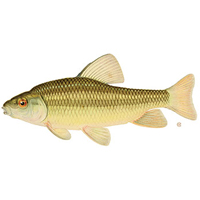Lake Chubsucker
Scientific name: Erimyzon sucetta

Photo credit: New York State Department of Environmental Conservation
Status
Endangered
“Endangered” means the species lives in the wild in Ontario but is facing imminent extinction or extirpation.
Date added to the Species at Risk in Ontario List
The Lake Chubsucker was already assessed as at-risk when the Endangered Species Act, 2007 took effect in 2008.
Read the most recent assessment report (PDF).
What it looks like
The Lake Chubsucker is a small member of the sucker family that reaches about 25 centimetres in length. It has a deep body with an arched back, a rounded snout, and a downward facing small sucker mouth. Its back is dark olive to greenish-bronze and the belly is green-yellow to yellow-white. There is sometimes a dark stripe along the side of the body that extends from the tail to the snout. This stripe is especially obvious in young fish.
Where it lives
Lake Chubsucker occurs in the eastern United States from Virginia to Florida and west to Texas. The northern extent of the species’ distribution includes the Great Lakes Basin. In Canada, the species has only been found in the southern Great Lakes.
Where it’s been found in Ontario
In Ontario, Lake Chubsucker has been documented in:
- Lake Huron
- Lake St. Clair
- Lake Erie
- a tributary of the Niagara River
The Lake Chubsucker lives in marshes and lakes with clear, still, warmer water and plenty of aquatic plants. This habitat is found in:
- bays
- channels
- ponds
- coastal wetlands
During the breeding season, from April to early June in Ontario, adults move into marshes where eggs are laid among vegetation in shallower water.
What threatens it
The main threat to the Lake Chubsucker is habitat destruction due to wetland drainage and too much sediment in the water. This species likes clean, clear water and does not do well in waters that are muddy or polluted. Water can become muddy due to soil washing in from nearby urban and agricultural areas.
Action we are taking
This species and its habitat are protected under Ontario’s Endangered Species Act, 2007 (ESA).
The ESA also requires us to prepare recovery guidance for endangered species such as Lake Chubsucker to guide recovery efforts for the species in Ontario.
All species listed on the Species at Risk in Ontario List may be eligible for consideration for government funding through the Species at Risk Stewardship Program.
Recovery strategy
A recovery strategy advises the ministry on ways to ensure healthy numbers of the species return to Ontario.
Read the executive summary and recovery strategy (June 15, 2012).
Government response statement
A government response statement outlines the actions the government intends to take or support to help recover the species.
Read the government response statement (May 31, 2013).
Five-year review of progress
A five-year review of progress made toward protecting and recovering a species is required no later than five years after the government response statement for that species is published.
Read the report on progress towards the protection and recovery of 17 species at risk, including the Lake Chubsucker (2018).
Habitat protection
General habitat protection - June 30, 2013
What you can do
Report a sighting
Submit your observations of species at risk to the Natural Heritage Information Centre (NHIC), which is Ontario’s conservation data centre. Join the centre’s Rare Species of Ontario project in iNaturalist, an online plant and animal identification app, to quickly and easily submit your observations.
Volunteer
Volunteer with your local nature club or provincial park to participate in surveys or stewardship work focused on species at risk.
Be a good steward
- Private landowners have a very important role to play in species recovery. If you find species at risk on your land, you may be eligible for stewardship programs that support the protection and recovery of species at risk and their habitats, such as the Species at Risk Stewardship Program.
- Invasive species seriously threaten many of Ontario’s species at risk. To learn what you can do to help reduce the threat of invasive species, visit:
- Farmers and land owners can help improve fish habitat and keep Ontario’s water safe and clean by maintaining natural vegetation next to creeks and rivers, and keeping pollution and soil from washing into Ontario’s rivers. You can find more information about programs and funding assistance for eligible farmers from organizations such as the Ontario Soil and Crop Improvement Association and ALUS Canada.
Report illegal activity
Report any illegal activity related to plants and wildlife to
Quick facts
- The scales on the upper half of the Lake Chubsucker are darkly outlined, making it look like the body of the fish has been crosshatched.
- Lake Chubsucker eats algae, plankton, molluscs and aquatic insects.
- Researchers know very little about the life history or biology of this species. It can be very hard to find this secretive fish, which lives in areas of dense aquatic vegetation.
- The presence of the Lake Chubsucker is a good indicator of healthy wetland habitats.